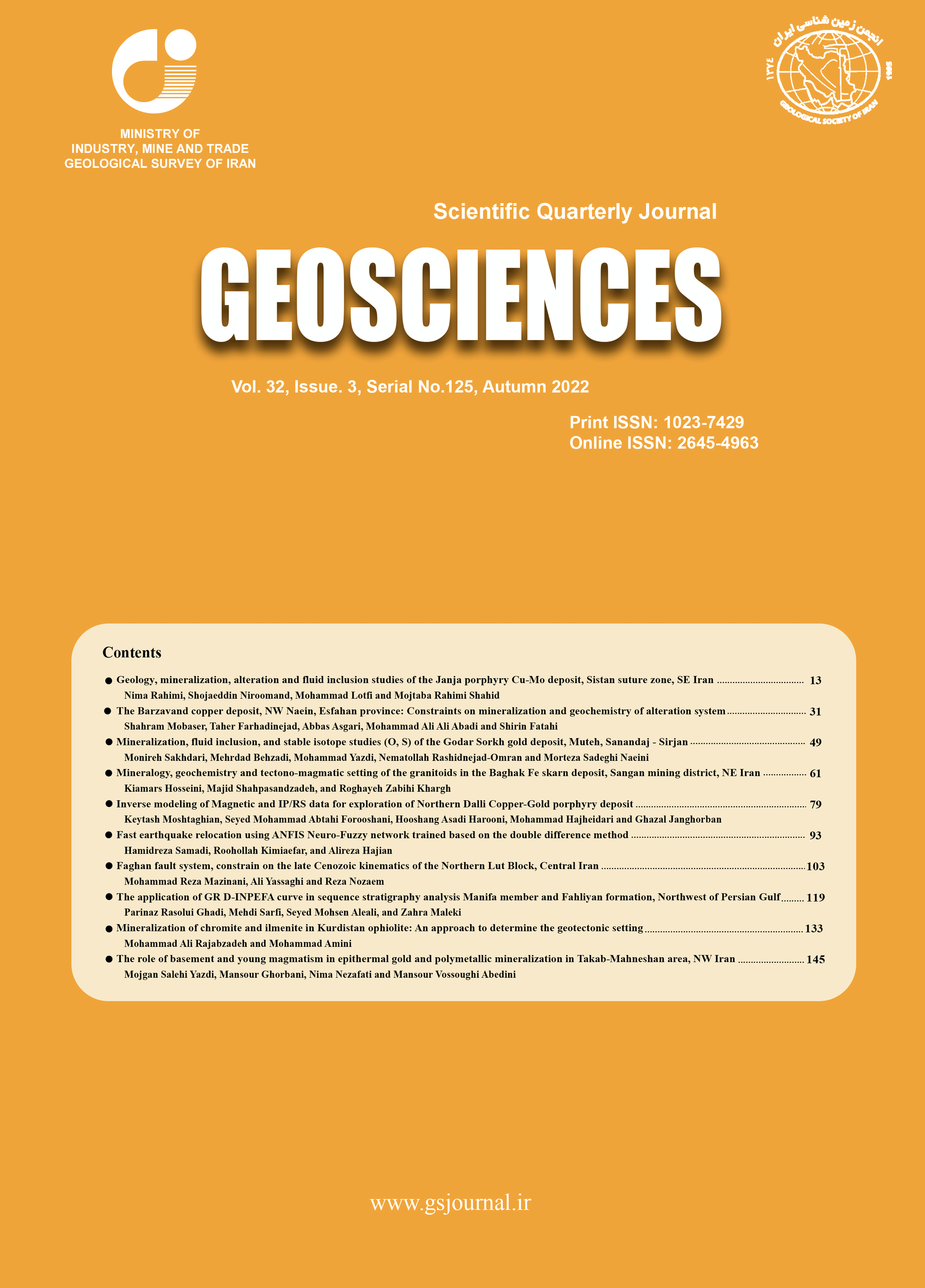Document Type : Original Research Paper
Authors
- Keytash Moshtaghian 1
- Seyed Mohammad Abtahi Forooshani 1
- Hooshang Asadi Harooni 1
- Mohammad Hajheidari 2
- Ghazal Janghorban 1
1 Department of Exploration, Faculty of Mining Engineering, Isfahan University of Technology, Isfahan, Iran
2 Mining Exploration Engineering/Department of Mining Engineering/Isfahan University of Technology/Isfahan/Iran
Abstract
The Dalli porphyry Copper-Gold deposit consists of two northern and southern indexes located on the Urmia-Dokhtar Volcanic Belt in Markazi province. Due to the presence of magnetite beneath the potassic alteration zone in the center of porphyry mineralization, a magnetometric survey was performed in the region. In the current study in the northern index, first, we extracted the local anomaly via removing the regional and aliasing effects from the magnetic data. Then, using three-dimensional inverse modeling of the reducted data illustrates the presence of a body with high magnetic susceptibility, in the depth range of 40 to 640 meters of the study area. A comparison between geochemical analysis of two exploratory core drilling with the depth variational model of the estimated magnetic susceptibility in the study area indicates a spatial correlation between increases in the grades of copper and gold and large variations of the magnetic susceptibility. Also, comparison between the magnetic susceptibility model and resistivity and chargeability models estimated from IP/RS data of three parallel profiles indicates a relation between sulfidic and altered mineralized zones and magnetic susceptibility variations. Therefore, the current study shows a high potential for the copper-gold mineralization in the northern Dalli index.
Keywords
Main Subjects
Behn, G., Camus, F., Carrasco, P., and Ware, H., 2001. Aeromagnetic signature of porphyry copper systems in northern Chile and its geologic implications, Economic Geology, 96(2), pp.239-248.
Chai, T., and Draxler, R.R., 2014. Root mean square error (RMSE) or mean absolute error (MAE)?–Arguments against avoiding RMSE in the literature, Geoscientific model development, 7(3), pp.1247-1250.
Clark, D.A., French, D.H., Lackie, M.A.. and Schmidt, P.W., 1992. Magnetic petrology: application of integrated rock magnetic and petrological techniques to geological interpretation of magnetic surveys, Exploration Geophysics, 23(2), pp.65-68.doi: 10.1071/EG992065.
Cooke, D.R., Agnew, P., Hollings, P., Baker, M., Chang, Z., Wilkinson, J.J., Ahmed, A., White, N.C., Zhang, L., Thompson, J., and Gemmell, J.B., 2020. Recent advances in the application of mineral chemistry to exploration for porphyry copper–gold–molybdenum deposits: detecting the geochemical fingerprints and footprints of hypogene mineralization and alteration, Geochemistry: Exploration, Environment, Analysis, 20(2), pp. 176–188.
Darabi-Golestan, F., Ghavami-Riabi, R., Khalokakaie, R., Asadi-Haroni, H., and Seyedrahimi-Nyaragh, M., 2013. Interpretation of lithogeochemical and geophysical data to identify the buried mineralized area in Cu-Au porphyry of Dalli-Northern Hill, Arabian Journal of Geosciences, 6(11), pp.4499-4509.
El Alaoui, M.E.A., Ouadif, L., Bahi, L., and Manar, A., 2020. Contribution of applied geophysics in mining prospecting, in E3S Web of Conferences. EDP Sciences, p. 3016.
Huang, X.W., Sappin, A.A., Boutroy, É., Beaudoin, G., and Makvandi, S., 2019. Trace element composition of igneous and hydrothermal magnetite from porphyry deposits: Relationship to deposit subtypes and magmatic affinity, Economic Geology, 114(5), pp. 917–952.
Li, Y., and Oldenburg, D.W., 1996. 3-D inversion of magnetic data, Geophysics, 61(2), pp.394-408.
Menke, W., 2018- Geophysical data analysis: Discrete inverse theory, Academic press. doi: 10.1007/978-90-481-3167-9_8.
Mostafaei, K., and Ramazi, H., 2017. Correlation between IP and Rs and grade data in modeling and evaluation of a copper deposit, case study: the Sarbisheh copper deposit, Iran, Journal of Tethys: Vol. 5(2), pp. 128–137.
Nabighian, M.N., 1972. The analytic signal of two-dimensional magnetic bodies with polygonal cross-section: its properties and use for automated anomaly interpretation, Geophysics, 37(3), pp.507-517.
Oldenburg, D.W., McGillivray, P.R., and Ellis, R.G., 1993. Generalized subspace methods for large-scale inverse problems, Geophysical Journal International, 114(1), pp. 12-20.
Oldenburg, D.W., and Li, Y., 1994. Inversion of induced polarization data, Geophysics, 59(9),pp. 1327-1341.
Oldenburg, D.W., Li, Y., and Ellis, R.G., 1997. Inversion of geophysical data over a copper gold porphyry deposit: A case history for Mt. Milligan, Geophysics, 62(5), pp.1419-1431.
Oldenburg, D.W., and Li, Y., 2005. Inversion for applied geophysics: A tutorial, Near-surface geophysics, pp. 89-150.
Oldenburg, D.W., and Pratt, D.A., 2007. Geophysical inversion for mineral exploration: a decade of progress in theory and practice, Proceedings of exploration, 7(5), pp.61-95.
Reynolds, J.M., 2011. An introduction to applied and environmental geophysics, John Wiley & Sons. doi: 10.1071/pvv2011n155other.
Salem, A. and Ravat, D., 2003- A combined analytic signal and Euler method (AN-EUL) for automatic interpretation of magnetic data, Geophysics, 68(6), pp.1952-1961. doi: 10.1190/1.1635049.
Salem, S.M., Arafa, S.A., Ramadan, T.M., and El Sayed, A., 2013. Exploration of copper deposits in Wadi El Regeita area, Southern Sinai, Egypt, with contribution of remote sensing and geophysical data, Arabian Journal of Geosciences, 6(2), pp.321-335.
Sillitoe, R.H., 1973. Geology of the Los Pelambres porphyry copper deposit, Chile, Economic Geology, 68(1), pp.1-10.
Sillitoe, R.H., 2010. Porphyry copper systems, Economic geology, 105(1), pp.3-41.
Vallée, M.A., Byrne, K., King, J.J., Lee, R.G., Lesage, G., Farquharson, C.G., Chouteau, M.. and Enkin, R.J., 2020. Imaging porphyry copper alteration using aeromagnetic data at Highland Valley Copper, British Columbia, Canada, Exploration Geophysics, 51(3), pp. 388–400.

